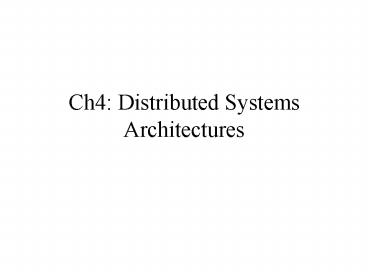Ch4: Distributed Systems Architectures PowerPoint PPT Presentation
Title: Ch4: Distributed Systems Architectures
1
Ch4 Distributed Systems Architectures
2
- Typically, system with several interconnected
computers that do not share clock or memory. - Motivation tie together multiple independent
computers over the network to - share resources, enhance performance, improve
reliability/availability, provide expandability. - One possible classification of architecture
- several minicomputers (machines with CPU/user
lt 1) - several hundred / thousand workstations
(CPU/user 1) - Processor pool (CPU/user gt 1)
- user typically has a dedicated CPU as well.
3
- What is an OS
- An interface between hardware and user processes
that provides an abstraction of the machine and
manages its resources. - What is a Distributed OS
- the same, except for distributed systems
- aims at transparency of distribution and presents
a virtual uniprocessor to the user. - according to some, the holy grail is to create a
metacomputer and a Problem Solving
Environment - The user sees a single machine that automagically
provides enough resources to do the task. The
task can range from simple hello world programs
to complex calculations.
4
Issues in Distributed OS
- Global state is not known
- due to lack of shared memory and clock,
unreliable message transmission. - Need decentralized controls
- temporal order of events ?
- Naming
- how should an object be identified ?
- Transparent ? Translucent ? Explicit ?
- URIs, URNs, URLs
- what if the object is replicated
- Scalability
- system should continue to work efficiently as
resources are added - consider a system that resolves IP addresses
using broadcast
5
- Compatibility / Interoperability
- binary level, execution level or protocol level
- homogeneous vs heterogeneous systems
- Process Synchronization
- mutual exclusion problem w/o shared memory
- Resource Management
- how do you get data to the location of the
computation - distributed filesystem ? distributed shared
memory ? - how do you migrate a computation (remote
evaluation) - RPC ? Client-Server ?
- how do you migrate running processes (code on
demand, mobile objects/agents) - Security
- authentication and authorization in a distributed
system
6
Structure of Distributed OS
- Monolithic kernel
- a (large) single entity that provides all the
services of the distributed OS - may not be a good idea since computer
configurations will vary - do you need to load disk drivers on a diskless
client ? - Collective kernel
- base OS functionality is in a relatively small
microkernel. All other OS services are processes
that run on top. - Microkernel will run on all machines
- OO approach
- same as collective kernel, but OS services are
implemented as objects - can provide a more structured approach than
collective kernel
7
Communication
- Review Section 4.6 yourself.
- Message Passing Model
- send and receive type primitives
- can be blocking(reliable, unreliable) or
non-blocking - use of buffers
- synchronous vs asynchronous
8
Millennium Project
- Work at Microsoft Research(paper by Bolosky et
al.) - Features
- seamless distribution, worldwide scalability,
fault tolerance, self-tuning, self configuring,
secure, resource control - Principles
- aggressive abstraction, storage irrelevance,
location irrelevance, JIT binding, introspection.

